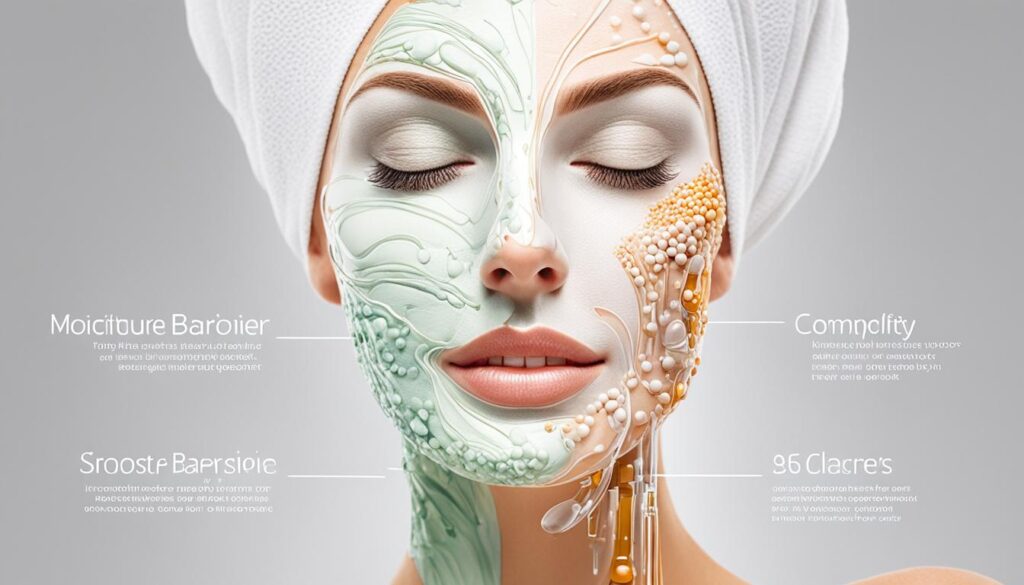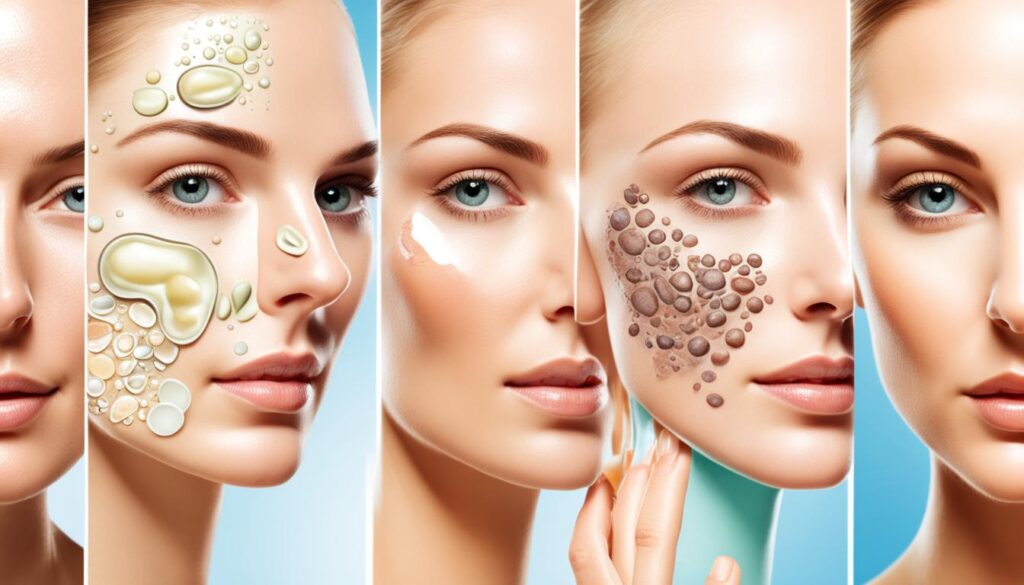Your skin is the biggest organ in your body. It does many important things like keeping your body at the right temperature and fighting off germs. The outer layer of your skin is called the skin barrier.
Knowing what type of skin you have is very important. It helps you pick the right skincare products. If you use the wrong products, you might get more skin problems.
What makes your skin type is your genes and how oily it is. Finding the right skincare products for your skin type helps you take care of it better. This can make your skin look bright and healthy.
Key Takeaways
- Understanding your skin type is crucial for selecting the right skincare products.
- Skin type is determined by genetics and oil production levels.
- Using the wrong products for your skin type can exacerbate skin issues.
- Identifying your skin type allows you to tailor your routine to address its unique needs.
- Achieving a healthy, radiant complexion starts with knowing your skin type.
Understanding the Importance of Skin Type
Your skin is the biggest organ in your body. It does many important jobs. It keeps your body at the right temperature and protects you from bad things outside.
Knowing what your skin type is helps you take good care of it. This means you can make a skincare plan just for you.
The Skin Barrier: Your First Line of Defense
The outer layer of your skin is called the skin barrier. It’s made mostly of things like ceramides. This layer keeps moisture in and bad stuff out.
It’s important for all skin types to have a healthy skin barrier. This helps your skin work right and stay healthy.
Every person’s skin is different. But, having a skin barrier that works well is key for good skin health. By knowing what your skin needs, you can make your skincare routine better. This helps your skin deal with daily challenges.
“A personalized skincare approach, based on your specific skin type, is the key to achieving and maintaining healthy, radiant skin.”

Your skin’s features, like how sensitive it is or how well it holds moisture, depend on your skin type. By understanding these things, you can make a skincare plan that’s just right for you. This helps your skin stay healthy and work well.
How to Determine Your Skin Type
Finding out your skin type is key to a good skincare routine. Most skin fits into five main types: oily, dry, normal, combination, or sensitive. You can use simple tests to figure out yours and what it needs.
The Bare-Faced Method
The “bare-faced method” is a way to check your skin type. Look at your skin 25 minutes after washing, before putting on any products. If it’s shiny or oily, you might have oily skin.
If it looks dry, flaky, or tight, you could have dry skin. If some parts are oily and others are dry, you might have combination skin.
The Blot Sheet Test
The “blot sheet test” is another good method. Press a clean tissue or blotting sheet on your skin and hold it up to the light. If the sheet soaks up a lot of oil, you have oily skin.
If it doesn’t absorb much oil, you likely have dry skin. If you see both oily and dry spots, you might have combination skin.
| Skin Type | Characteristics | Signs |
|---|---|---|
| Oily | Skin produces excess sebum, appearing shiny or greasy | Frequent breakouts, enlarged pores, blackheads |
| Dry | Skin lacks natural oils, appearing dull, rough, and flaky | Tightness, peeling, visible fine lines |
| Combination | Combination of oily and dry areas on the face | Shiny T-zone, dry cheeks, occasional breakouts |
| Normal | Skin is balanced, not too oily or too dry | Even tone, small pores, few blemishes |
| Sensitive | Skin is easily irritated, reactive to products | Redness, stinging, itching, rashes |
Figuring out your skin type might take some tries, but these tests are a good start. Once you know your skin’s type, you can pick products that fit your needs. This way, you can take care of your oily vs dry skin signs and combination skin identification.

Oily Skin Characteristics and Care
If your skin looks shiny and feels greasy, you might have oily skin. This type of skin is less likely to get wrinkles. But, it can cause clogged pores, acne-prone skin, and blackheads and whiteheads.
To take care of oily skin, you need a special routine. Start with a gentle, foaming cleanser to clean off dirt and oil. Then, use a light, oil-free and non-comedogenic moisturizer to keep your skin moist without clogging pores.
- Look for oil-controlling skincare products made for oily skin.
- Stay away from thick, creamy moisturizers. Choose water-based or gel-based ones instead.
- Use non-comedogenic ingredients like hyaluronic acid, niacinamide, and salicylic acid that won’t clog pores.
- Exfoliate often to get rid of dead skin and open up pores. But be careful not to dry out your skin.
By knowing how to spot oily skin signs and using the right oil-controlling skincare products, you can have healthier, more balanced skin.
Dry Skin Characteristics and Care
Dry skin is a common issue that can be tough to handle. It doesn’t have enough oils, making it look dull, rough, and flaky. To fix this, we need to find out why it’s dry and use the right moisturizers.
Identifying Dry Skin Signs
Dry skin shows these signs:
- Dull, lackluster complexion
- Rough, scaly, or flaky texture
- Tightness and lack of elasticity
- Visible fine lines and wrinkles
- Increased sensitivity and irritation
This happens because the skin’s barrier is weak. It can’t keep moisture in well. So, the skin gets dry and looks dehydrated.
Caring for Dry Skin
To help dry skin, we need to use hydrating ingredients in our skincare. Look for products with:
- Ceramides to strengthen the skin’s protective barrier
- Hyaluronic acid to attract and retain moisture
- Glycerin to lock in hydration
- Occlusives like shea butter or petroleum jelly to seal in moisture
Don’t use harsh cleansers. Instead, choose gentle, creamy ones. Also, watch out for things that make dryness worse, like low humidity or too much sun.
By focusing on dry skin’s needs and using the right moisturizers, we can make our skin healthy and hydrated. This helps reduce dryness, roughness, and irritation.
Normal Skin Characteristics and Care
If you have normal skin, you’re really lucky. It’s the best skin type, looking balanced and healthy. People with normal skin rarely get breakouts, flakiness, or feel greasy or tight.
Normal skin has small pores, feels smooth, and looks even and bright. It doesn’t need as much intensive care as other skin types. But, it’s still important to take good care of it to keep it looking great.
For normal skin, focus on hydration and barrier support. A good skincare routine that locks in moisture and nourishes the skin’s protective barrier is key.
“Maintaining normal skin is all about striking the right balance – not too dry, not too oily, just perfectly healthy and radiant.”
Use the right hydrating and barrier-supporting products to keep your normal skin balanced and glowing. Even with normal skin, sticking to a good skincare routine is key to looking young and healthy.
How to Determine Your Skin Type and Choose the Right Products
Finding out your skin type is key to picking the right skincare products. It’s not just about knowing the basics of different skin types. There are better ways to really understand your skin.
Try the “watch and wait” method. Clean your face, then see how it feels and looks for 30 minutes. If it’s shiny or greasy, you might have oily skin. If it’s dry and tight, you could have dry skin. Normal skin feels good and balanced.
- The blotting sheet method is also helpful. Press a clean blotting sheet on your bare skin and see how much oil it takes up. If it takes a lot of oil, you might have oily skin. If it doesn’t take much oil, you could have dry skin.
Knowing your skin type helps you pick the right skincare products. Using the wrong products can make things worse. If you’re unsure, talk to a board-certified dermatologist. They can give you a personalized skin check and help you find the best skincare routine.
| Skin Type Assessment Methods | Personalized Skincare Solutions | Product Selection Guidance | Dermatologist Consultation |
|---|---|---|---|
| – “Watch and wait” method – Blotting sheet test |
– Targeted product formulations – Addressing specific skin concerns |
– Identifying the right ingredients – Avoiding problematic products |
– Professional skin analysis – Customized skincare routine |
Understanding your skin type can really help you choose the best skincare products. It’s worth the time.
Combination Skin Characteristics and Care
Combination skin is special. It has oily and dry spots. The T-zone (forehead, nose, and chin) gets oily. But the cheeks stay dry. This mix changes with the seasons or stress.
Good skin care means focusing on both oily and dry areas. You need to use products that help with both.
Balancing the Zones
It’s important to balance moisture and oil control for combination skin. Use a gentle, oil-free cleanser on the oily T-zone. Then, apply a hydrating moisturizer to the dry cheeks.
Using targeted skincare products for each area is key. This keeps your skin looking great.
- Use a lightweight, gel-based moisturizer on the T-zone to control shine
- Apply a richer, more emollient cream on the cheeks to alleviate dryness
- Exfoliate gently to slough off dead skin cells and unclog pores
- Blot excess oil with blotting papers throughout the day
By taking care of each area, you can balance your combination skin. This makes it look and feel amazing.
Sensitive Skin Characteristics and Care
If your skin gets easily red or itches, it might be sensitive. Sensitive skin often shows signs like redness, burning, itching, or dryness. These signs come from things in skincare products that bother your skin.
It’s important to know what your skin doesn’t like. Use fragrance-free and hypoallergenic products. Stay away from harsh chemicals, dyes, and alcohol. These can make sensitive skin worse. Instead, choose products with calming ingredients to help soothe your skin.
- Common signs of sensitive skin include redness, burning, itching, and dryness.
- Sensitive skin is more likely to react to things like certain ingredients and the environment.
- Use fragrance-free and hypoallergenic products with calming ingredients to help your sensitive skin.
| Ingredient to Avoid | Why to Avoid It |
|---|---|
| Fragrance | Can be a common irritant for sensitive skin |
| Alcohol | Can dry out and further irritate sensitive skin |
| Harsh Chemicals | Can cause redness, burning, and inflammation |
By knowing what your skin needs and picking the right fragrance-free and hypoallergenic products, you can take good care of your sensitive skin.
“Sensitive skin needs a gentle, careful approach to skincare. Avoid harsh irritants and choose calming, nourishing products for the best skin health.”
Aging and Acne-Prone Skin Considerations
As we get older, our skin changes. Anti-aging skincare helps fight the signs of aging. But, if you have acne-prone skin, you need to focus on that too. Using the right products is important for a young, healthy look.
People with acne-prone skin should avoid comedogenic ingredients. These can make breakouts worse. Choose non-comedogenic products instead. Adding collagen-boosting ingredients can also help. They make skin more elastic and reduce fine lines and wrinkles.
- Avoid products with heavy oils, thick creams, and fragrances that can clog pores and trigger acne
- Look for anti-aging serums and moisturizers infused with collagen-boosting ingredients like retinol, vitamin C, and peptides
- Exfoliate regularly to slough off dead skin cells and reveal a brighter, more youthful complexion
By tackling both anti-aging and acne-prone skin issues, you can get a balanced, glowing look. Create a skincare routine that fits your skin type and needs for lasting results.
“Glowing, youthful skin is achievable at any age with the right collagen-boosting and non-comedogenic products.”
Conclusion
Knowing your skin type is key to a great skincare routine. It helps you get a glowing, healthy look. Whether your skin is oily, dry, normal, combination, or sensitive, there are special solutions for you.
By learning about your skin and using the right ingredients and products, you can take good care of it. This keeps your skin’s protective layer strong.
Skincare isn’t the same for everyone. Try different things and get advice from experts to find what’s best for you. With a plan made just for you, your skin can shine and be strong.
Use what you know about your skin to start a skincare journey that makes your skin better. Understanding your skin type and what it needs is the first step to better skin health and beauty.
FAQ
What are the different skin types and how do I determine mine?
How do I care for oily skin?
What are the signs of dry skin, and how do I treat it?
How do I care for normal skin?
How do I care for combination skin?
How do I care for sensitive skin?
How do I choose the right skincare products for my skin type?
Source Links
- What Type of Skin Do I Have? – https://www.cerave.com/skin-smarts/skincare-tips-advice/what-skin-type-do-i-have
- Skin Type & Skin Care – https://my.clevelandclinic.org/health/drugs/10981-know-your-skin-type-before-choosing-skin-care-products
- How to Determine Your Skin Type—And Why it Matters – https://www.dermstore.com/blog/what-is-my-skin-type/














